A FAILING AIR CONDITIONER quickly leads to uncomfortable camping. As the temperature inside an RV rises, most of us get desperate to find a solution to why our RV AC isn’t working. Our first suggestion? Find somewhere indoors with AC, grab a cool beverage, and dive into this RV air conditioner troubleshooting guide!
Key Takeaways
- Common RV AC issues include power failures, tripped breakers, poor cooling, short cycling, water leaks, and strange noises or smells. Each symptom often stems from electrical problems, dirty components, airflow blockages, or thermostat malfunctions.
- Thorough troubleshooting requires specific tools and careful inspection of power sources, filters, ductwork, coils, and electrical components. Technicians recommend letting the AC run 20–30 minutes before testing to get accurate readings.
- If DIY fixes don’t resolve the problem—or you suspect serious issues like refrigerant leaks or compressor damage—it’s time to schedule professional RV AC service. Regular maintenance is key to preventing costly repairs and keeping your RV cool and comfortable.
Table of Contents
ToggleCommon RV Air Conditioner Problems
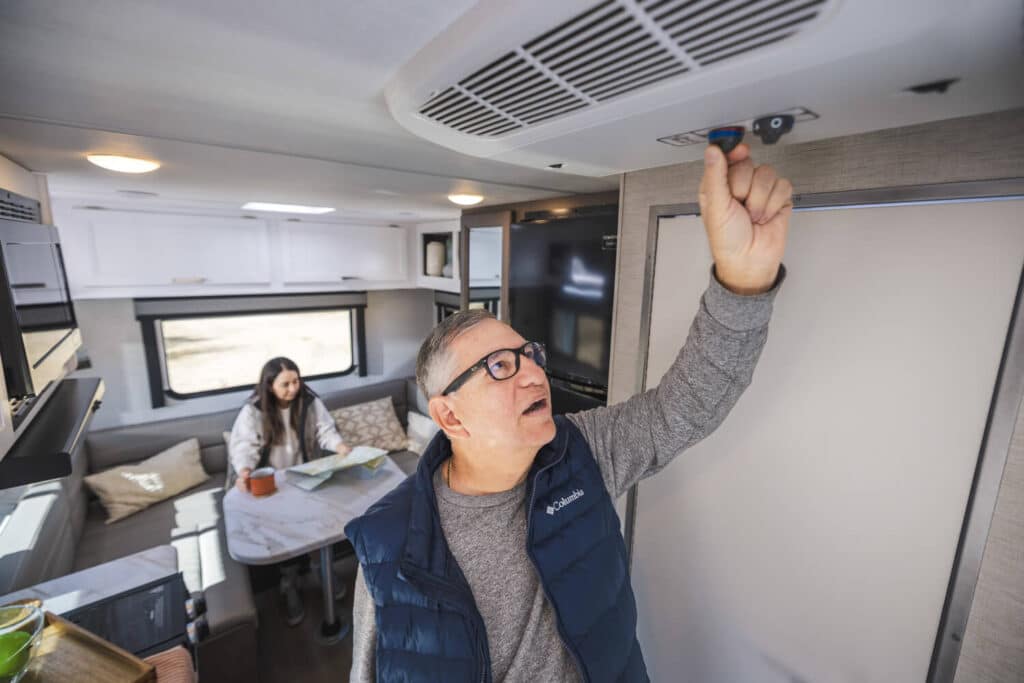
These are some of the most common RV air conditioner problems that require troubleshooting:
- Not turning on (or turns on and trips a breaker shortly thereafter)
- Lack of cooling capacity or blowing warm air
- Short cycling
- Water dripping inside
- Performance varies by location
- Strange noises and/or foul odors
Are you experiencing another problem? Drop us a comment below so we can provide further troubleshooting assistance!
Tools Required
Depending on your issue, you may need the following RV tools to troubleshoot your air conditioner:
- Digital multimeter with built-in AC/DC amperage clamp.
- Surge protector to guard against shore power issues.
- Anemometer to test airflow.
- Flashlight and/or mirror to inspect ductwork (can also use endoscope-style attachment for cellphone).
- 1-2 probe-type thermometers to measure discharge and return air temperatures.
- Fin comb set and a vacuum cleaner with a duster brush attachment to straighten and/or clean coils and fins. Compressed air and a blow gun can also be used, with care.
- Small flathead screwdriver or dental pick for removing screw covers on the ceiling assembly.
- Driver/drill and drill bit set for disassembling and reassembling components.
- Calculator to accurately determine acceptable ranges.
Technician Tip: When diagnosing an A/C, we have to let it run for 20-30 minutes because as it warms up, the pressures inside it will build. This causes the amperage to climb, but it is also the point where the A/C is at peak efficiency. By allowing it to “warm up” before testing the amps, volts, and temperatures, we can be certain our numbers are extremely accurate.
How To Troubleshoot an RV Air Conditioner
Let’s examine these common RV AC issues one by one, providing helpful causes and troubleshooting tips for each. Let’s start with the most obvious: a lack of power.
AC Is Not Turning On
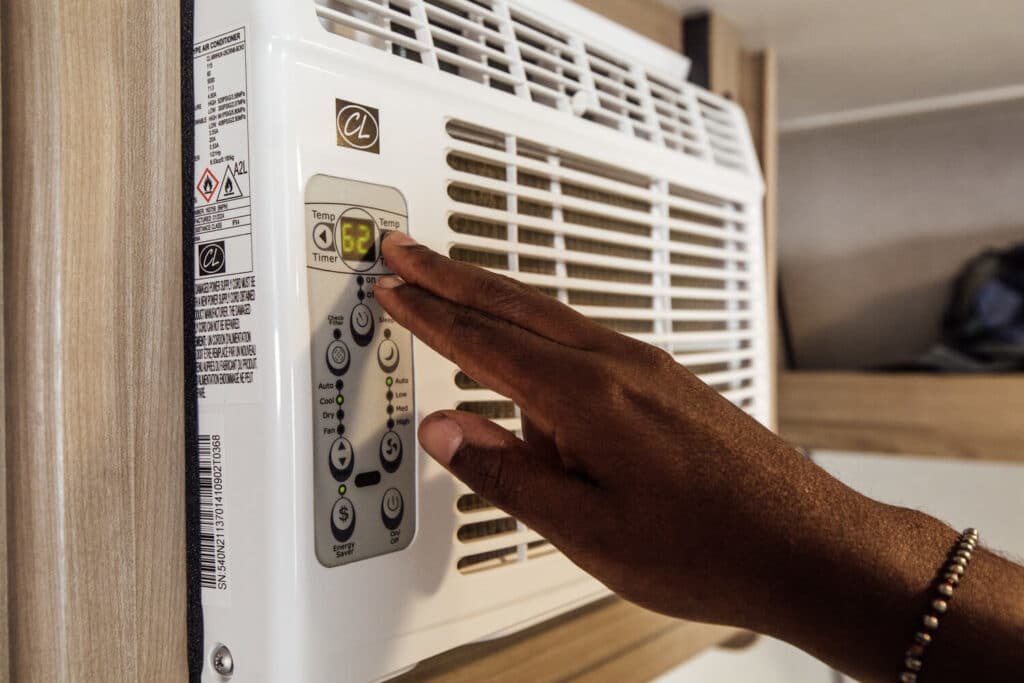
While an AC’s fan and compressor rely on 120VAC power (from shore power or a properly-sized generator), the thermostat and AC controls typically require 12VDC power from your RV’s battery bank.
For starters, most RVs—except for a handful with larger solar/battery systems and soft-starting ACs—must be connected to shore power or a generator to run the air conditioning system. So, first check you’re actually connected to the proper power source (30 or 50 amp or an adequately sized RV generator).
If you are connected but your thermostat isn’t turning on or nothing happens when you change the controls directly on the interior panel, you may have a 12VDC electrical issue. This can lead us back to your battery bank, converter, or wiring.
Solutions:
- Check the power at the pedestal. Is the breaker on? Can you measure sufficient voltage according to the outlet’s power rating?
- Check battery voltage, clean terminals, and ensure the security of battery cables.
- Checked for blown fuses and/or tripped breakers.
- Ensure the battery disconnect is on.
- Troubleshoot issues with your RV converter.
AC Keeps Tripping a Breaker

Depending on the BTU rating and number of AC units on your RV, it’ll either be rated for 30 or 50-amp shore power. Air conditioners with a higher BTU rating—and RVs with multiple ACs—will require more power than smaller campers.
To power your AC, you’ll need to plug into a shore power connection—or a generator—that matches your RV’s power requirements. Theoretically, you can plug a 50-amp RV into a 30-amp source or a 30-amp RV into a standard 120VAC outlet. However, don’t expect to enjoy the full benefits of air conditioning because the RV will be limited to the outlet’s capacity. Adapters don’t increase the available power; they only allow a plug to fit a different size outlet.
If your AC turns on but trips a breaker shortly after, you’re most likely overloading the system. Are you trying to run the microwave simultaneously? Did you forget to power off your AC before turning on the hair dryer? Is your gas/electric water heater set to the electric mode? Is there an issue with an A/C component? Power demands add up quickly, and RV electrical systems don’t function exactly like your home.
Furthermore, issues like a worn start capacitor, low voltage, electrical spikes, and miswired outlets can cause problems with your RV air conditioner and the entire electrical system. These unseen issues could trip a breaker at the pedestal or inside your RV.
Solutions:
- Use a surge protector to guard your RV against low/high voltage, miswired pedestals, and other electrical issues.
- Limit other 120VAC appliance usage while running your RV air conditioner.
- Employ a Camping World Certified Technician to inspect the start capacitor and replace it, as needed, to prevent excessive current draw.
Technician Tip: An AC start capacitor stores a lot of electricity and is designed to release it very quickly, as soon as it has a pathway to ground. If you open the protective enclosure around the capacitor and accidentally touch the terminals, YOU can become that pathway.
AC Doesn’t Keep RV Cool

Our next potential issue is an RV that doesn’t cool or blows warm air. The fan has power and blows air, but the interior temperature never drops to the thermostat’s setpoint. It just keeps blowing warm or mildly cool air.
The first potential issue is a dirty or clogged filter, which can reduce airflow over the evaporator coils by as much as 50%. A dirty filter can also lead to dirty coils, reducing your air conditioner’s efficiency.
That dirty air filter can also cause evaporator coils to freeze due to a lack of airflow. Low refrigerant can also cause this issue, often resulting from a small leak in a factory-sealed rooftop air conditioning unit.
Additionally, you could feel warm air from your A/C vents because of holes in the system. In ducted systems, foam or coil collars can leak or separate, which allows cold air to escape into the return air space or roof cavity before it’s directed through the ductwork and into the room.
Solutions:
- Clean air filters to ensure adequate airflow.
- If you see ice on the coils above the filter, turn the A/C off for 30 minutes. Then, run the fan to ensure the coils are thawed before restarting and monitoring performance.
- Remove the interior A/C cover and inspect for leaks or separations where the return air supply could be mixing with warm air. Inspect inside the ductwork for holes, collapsed areas, or separations that allow cold air to be lost or blocked. Use HVAC foil tape to seal problem areas.
RV Air Conditioner is Short Cycling
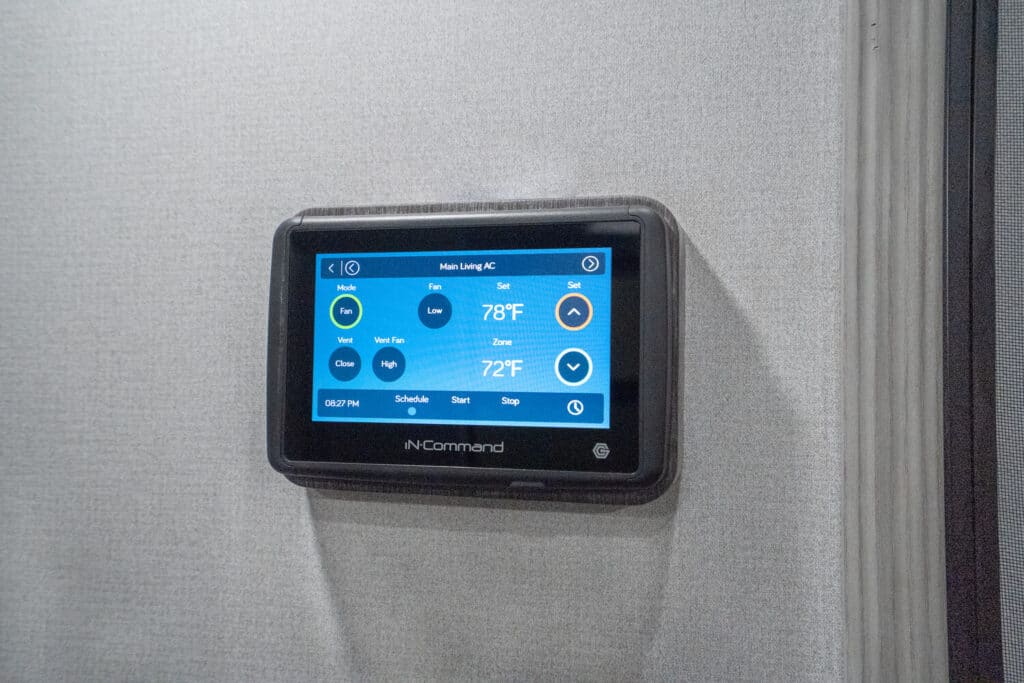
Here’s how a standard RV air conditioner normally works: the fan starts running after you turn it on and set the thermostat to a temperature lower than the current room temperature. A few seconds later, the compressor kicks in. Once your desired temperature is reached, the compressor cycles on and off periodically to maintain it efficiently.
Short cycling occurs when your compressor turns on and off more frequently than normal. It could be caused by low voltage from a campground power source, a broken or malfunctioning thermostat, a worn start capacitor, frozen coils, or a lack of airflow.
Overcooling is another common cause that’s often overlooked because it results in icing, which causes many to inspect for a dirty filter and coil issue. It occurs when the thermostat is turned down excessively. When the air temperature drops at night and everyone is sleeping, they breathe and perspire a considerable amount of humidity inside the RV. The A/C is able to get really cold, but the result is often significant ice buildup.
Technician Tip: Overcooling can also happen during the day on RVs with a second A/C, especially if the biggest A/C possible was installed instead of the best size for a given application—more common in aftermarket, DIY installations.
On especially hot summer days, campground voltages have been known to drop below 105 volts, which can overheat your compressor and cause it to shut down.
Solutions:
- Use a digital multimeter to check campground voltage to ensure it’s above 108 volts. If it is not, consider switching parks or using an autoformer.
- Maintain your RV battery monthly and replace the batteries in battery-powered AC thermostats at least twice a year.
- Consider relocating the thermostat if it’s on an outside wall. It can also be moved if it’s positioned near a hot appliance like the stovetop, or in a location where an AC vent blows directly on it.
Water Drips Inside from the AC
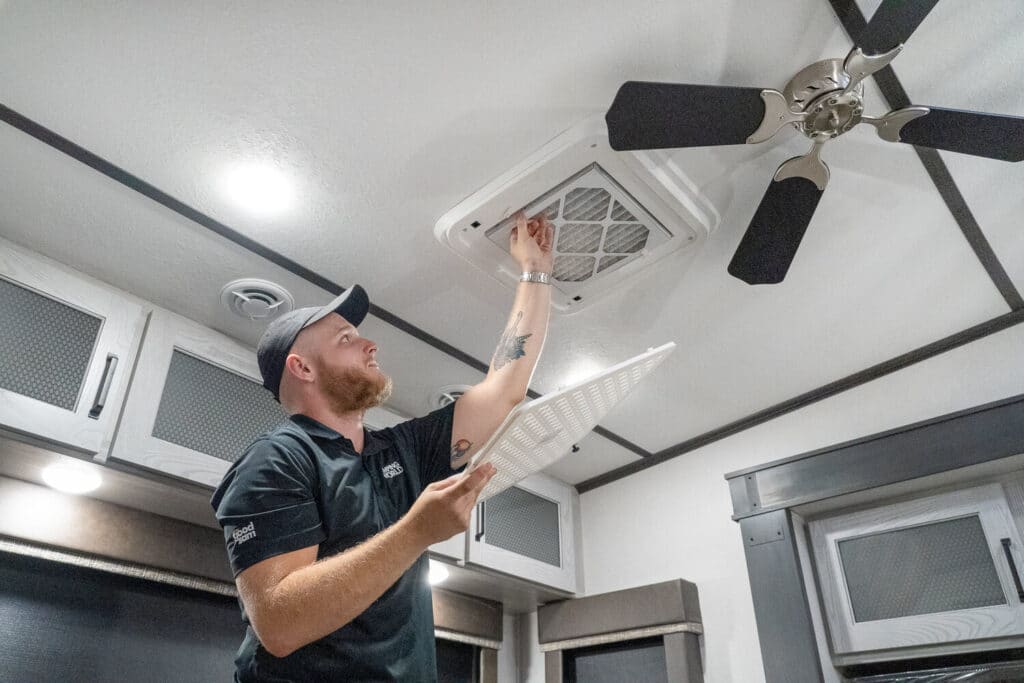
You walk through your RV and feel water drip on your head. No, you’re not imagining things. This is an unfortunate issue leading to RV air conditioner troubleshooting, but the cause can typically be traced to one of four possibilities: a dirty or clogged filter, an impacted drain pan or line, improper installation, or a broken pump.
Ductwork leaks, separations, or impingements can also lead to condensation and dripping if cold air leaks into the return air plenum. On some models, a worn-out or overtightened gasket presses the drain hole into the rubber roof membrane, preventing water from passing through.
Solutions:
- Clean air filters and coils to ensure adequate airflow.
- Inspect the drain pan and line. Remove dirt and debris that is preventing proper drainage.
- Ensure proper alignment of the exterior gasket over the roof opening to prevent leaks.
- Check that the compression of the exterior gasket meets the manufacturer’s recommendation—typically 50% compression.
- Remove the interior A/C cover and inspect for leaks or separations where the return air supply could be mixing with warm air. Inspect inside the ductwork for holes, collapsed areas, or separations that allow cold air to be lost or blocked. Use HVAC foil tape to seal problem areas.
- Schedule an AC inspection to have the pump, gasket, drain pan, and other components professionally inspected.
Read our complete troubleshooting guide for this issue:
Technician Tip: Most drain pans are integrated into the A/C chassis, which means that damage may require a complete replacement of the entire roof unit portion. Alternatively, Tiffin and Airstream are two manufacturers known for using A/C drain pans with hoses or pumps.
AC Makes Strange Noises and/or Emits Foul Odors
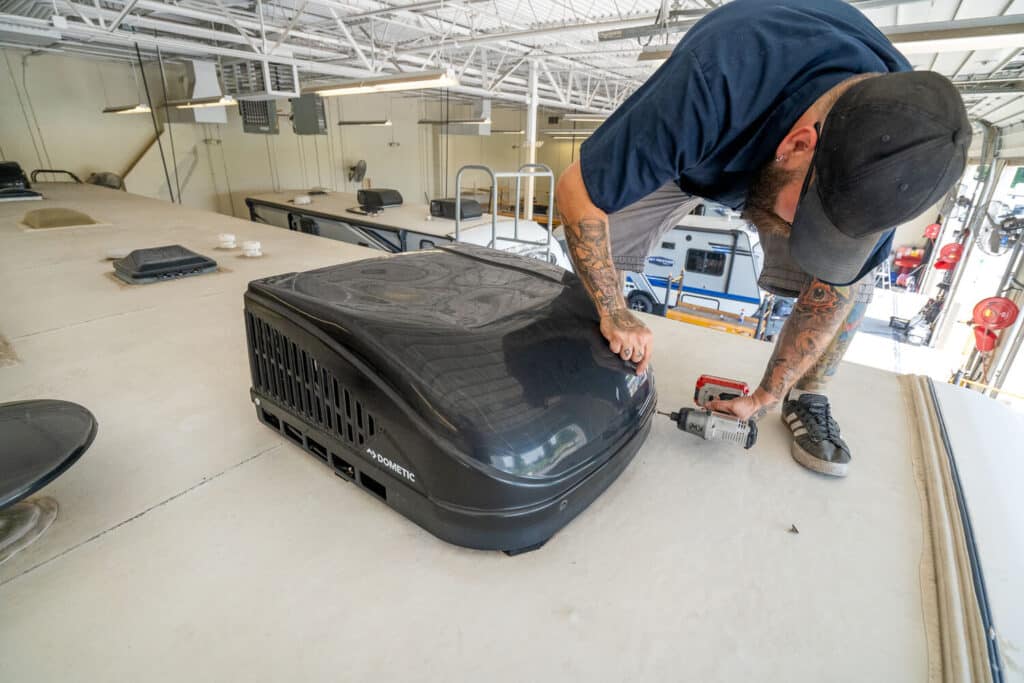
RVs are subject to significant bumps and vibrations as you drive, not to mention the environmental exposure when camping, driving, or in storage. Bolts and screws can come loose, bearings can dry out, mold or mildew can grow, wasps, mud daubers, rodents, and others can nest in the A/C, etc.
All these things—and more—can lead to strange noises, vibrations, foul odors, or even complete RV air conditioner failure.
Solutions:
- Check/tighten mounting bolts, adhering to the manufacturer’s torque specifications. Some tighten from above, requiring the removal of the A/C shroud. Most tighten from inside, requiring the removal of the entire ceiling assembly cover to access the bolts.
- Ensure the fan blades aren’t rubbing against the housing and realign the set screw as needed.
- Listen for a high-pitched squeal signaling dry motor bearings. Consult the A/C manufacturer about the proper oil type, amount, and lubrication method.
- Flush the drain pan with a 50/50 diluted white vinegar solution and rinse thoroughly with clean water to remove algae.
- Spray a non-corrosive coil cleaner on the fins and rinse with water at low pressure to remove mold growth—AKA “black crud.”
Technician Tip: Full-strength automotive antifreeze, ethylene glycol, actually has cleaners and protectants suitable for plastics, copper, and aluminum. This makes it a great cleaner and protectant for cleaning fins. It also lubricates them, making combing much easier.
When Should I Get My RV AC Issues Diagnosed?
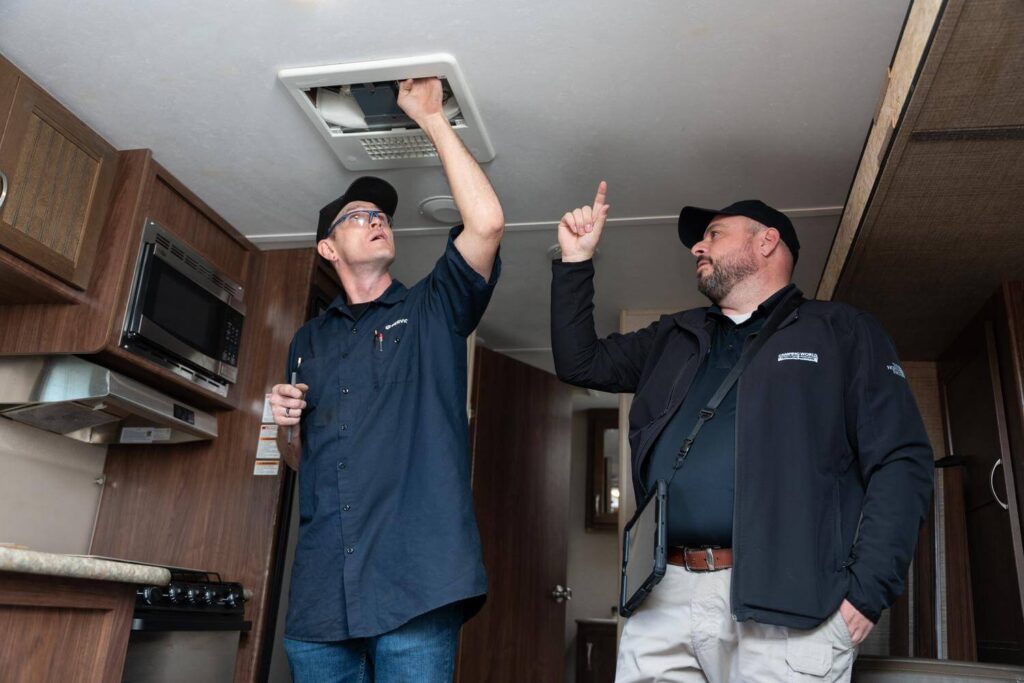
Regular cleaning and inspection are the best ways to keep the air conditioner in your RV working at peak efficiency. A diligent air conditioner maintenance routine will catch many minor issues.
However, if you’ve neglected maintenance or tried your share of RV air conditioner troubleshooting without success, it’s time to contact a Camping World Certified RV technician. But let’s also summarize the most common aforementioned issues that require additional attention.
After some testing, you suspect:
- A worn start capacitor
- A refrigerant leak
- A broken pump
- An under (or over) compressed gasket
- Drain pan or A/C chassis damage
- Suspected compressor issue or motor failure
- Burnt wiring smells
In truth, any air conditioner problems in your RV could require professional assistance. If you are outside your comfort zone for DIY troubleshooting and repairs, contact a certified technician to inspect your air conditioning system.
Having other RV issues? Use these other troubleshooting resources:
Did these RV air conditioner troubleshooting tips resolve your issue? Let us know if we can provide further assistance in the comments below!
Author
-
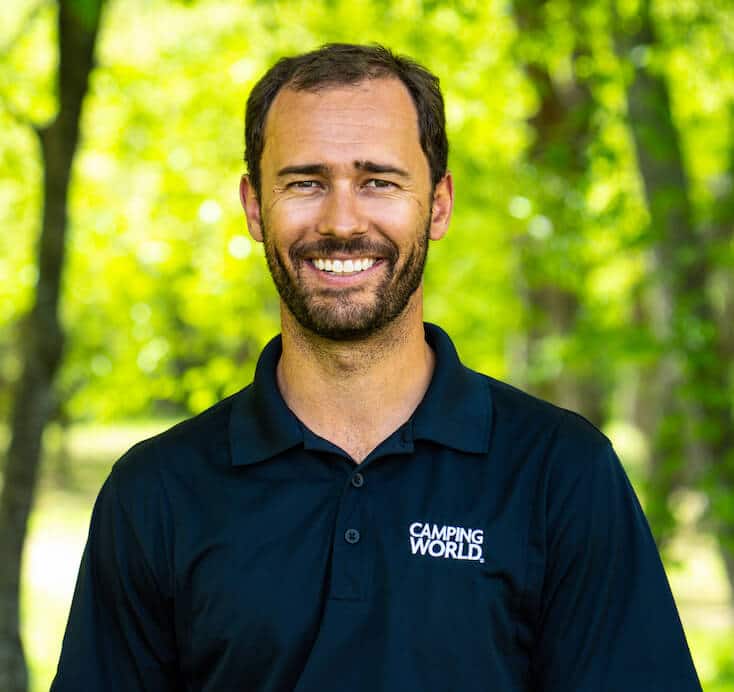
Tucker Ballister is our Content Strategist. He grew up RV camping in a Fleetwood Bounder with his parents and has lived and camped in two motorhomes and two travel trailers of his own. His current RV is a 2025 Forest River Campsite Ultra 26BW, which he loves taking on adventures with his wonderful partner and furry companion from their home base in Western North Carolina. Check out his adventures, gear reviews, and outdoor advice at thebackpackguide.com.
View all posts









The AC after it’s on for a bit, a “fire alarm” sound goes off. Where should I start looking? It is an Ice Castle RV edition. 2013 I think.
Hi Jeff,
What is your AC’s make/model? Have you also checked that this sound isn’t coming from your CO/LP Leak Detector? This detector could require a reset or a battery replacement.
Looking forward to your reply.
thank you
good info
You are most welcome!